Richard Taylor, Merivale High School, Ottawa, CAP Representative
richard@teya.ca
Physics is happening in Canada, and this year the place to see it all is Ottawa. I was at the annual Congress of the Canadian Association of Physicists. Recognizing the importance of inspiring young people, there was a special day for high school teachers on June 14. Next year the CAP Congress will be at Queen’s University in Kingston from May 29 to June 2. Don’t miss it!
About 30 teachers from the area got together on Tuesday for a full and intense day of talks, workshops and tours. Most were from Ottawa, but I also met teachers from Toronto, Brockville and Renfrew. It’s difficult getting away from school for a day at this time of year, but with a supportive department head or principal, arrangements can be made. Certainly the CAP, the University of Ottawa, the Perimeter Institute and TRIUMF were very generous in making this day possible at a very minimal cost to the participating teachers. In fact, CAP allows high school and CEGEP teachers to attend the entire Congress at no extra cost! I’m very lucky to be able to take advantage of this generosity because I’m currently on leave from my teaching position. Kingston teachers take note for 2017.
Our day began with a talk by Paul Corkum about “Attosecond Science”. Dr. Corkum took a moment to thank his grade 10 Physics teacher for inspiring him to pursue a career in Physics. The particular topic that he still remembers was dimension analysis: how beautifully logical it was that the formula for calculating velocity is directly related to the units we use! With that introduction, he made a lovely segue into the dimensions of attosecond science. What is an attosecond? 1 × 10
-18 seconds, which has the same ratio to 1 second as 1 second has to the age of the universe (I just checked, and it’s actually closer to twice the age of the universe. But right order of magnitude.) Dr. Corkum then took a moment to describe a bit of history. About 150 years ago, a photographer Eadweard Muybridge was asked to settle a bet about whether a galloping horse’s feet all left the ground at once. He created an elaborate (and expensive) setup in which the moving horse triggered 12 high speed cameras in precise sequence as the horse galloped past a brilliantly lit background. Dr. Corkum now does something similar with high intensity bursts of laser light which can be as short as 67 attoseconds. The “horses” that he is photographing are individual electrons as they move around in integrated circuits or chemical reactions. Piecing together hundreds of flash pictures enables his team to reconstruct the full 3D shape of electron orbitals.
We then moved to another lecture hall where we joined other Congress participants for a talk by this year’s winner of the
CAP Medal for Excellence in Teaching Undergraduate Physics, James Fraser of Queen’s University (coincidentally, the organizer of next year’s Teacher’s Day). His talk was about Going “Interactive”: Developing Scientist-Apprentices in the Physics Lecture Hall. Prof. Fraser’s main insight into teaching is that we should treat students more like junior members of a scientific or engineering research team. Don’t waste valuable team time with information transfer — that is more efficiently done individually. Team meetings should be used for active discussions about the parts of the information that are difficult or controversial. (Teachers who have heard about the “flipped classroom” will recognize this theme.) Be humble. One teacher cannot teach 300 (or even 30) other individuals properly. Team members learn from each other and help each other. Fraser then conducted an exercise similar to what he does in his Physics “lectures”. We had all been given a paper with the letters A, B, C, D printed on it. We now used these to answer a couple of Physics questions and display our answers to the teacher. When the answers were 30% to 70% correct, were told to discuss our answers with people nearby and try to convince each other of the merits of our answer. The question was re-posed and the answers improved. Regular readers of this newsletter and participants in the OAPT Conference will also recognize this technique. Finally, Fraser addressed the problem of evaluation. He is increasingly uncomfortable with basing the mark for his undergraduate courses on a final exam that is written in one session, individually. He contrasted this with the much more interactive and on-going process that is used to evaluate Masters and PhD students. So he is now beginning to try using a two-stage process for his undergraduate final exams: the first stage is the typical, individually written final exam, but for two hours instead of three. Then, after students hand in their individual answers, they have a second stage of re-writing the
same exam, in their groups, open-book. Fraser finds that this makes the exam much more of a learning experience rather than just an evaluation.
Back to the Physics building for Perimeter Institute’s travelling road show: Glenn Wagner and Damian Pope doing hands-on activities to help students understand the principles behind the Event Horizon Telescope and the LIGO discovery of gravitational waves. I was particularly impressed with Glenn’s demonstrations of angular size and telescope resolution using very simple equipment: pencils, rubber bands, Popsicle sticks and a photocopied protractor. Watch for this coming soon in the
Perimeter Institute’s suite of resources.
Then it was off to the University of Ottawa’s undergraduate Physics labs to do a few experiments. Although the labs are still in the traditional arrangement of linear lab benches, their equipment and processes are very modern. Students work in groups to investigate physical phenomena. Each group has a computer connected to various sensors. They use Logger Pro to collect and analyse the data. It was a real treat to be able to play with a full set of fully working equipment, and to start gathering good quality data within just a few minutes. U of O’s lab technicians and lab supervisors are to be commended! The actual experiments were mostly familiar (Fletcher’s apparatus, “cart” on a slope, projectile motion, multiple slit diffraction), but there was one that was new to me: measuring the intensity of light passing through two polarized filters as a function of angle. According to the theory, this is a cosine squared function — not one we usually encounter in high school. U of O’s Physics Department is trying to encourage teachers to bring their students to the campus for a day of similar activities. Contact
phyinfo@uOttawa.ca for more information.
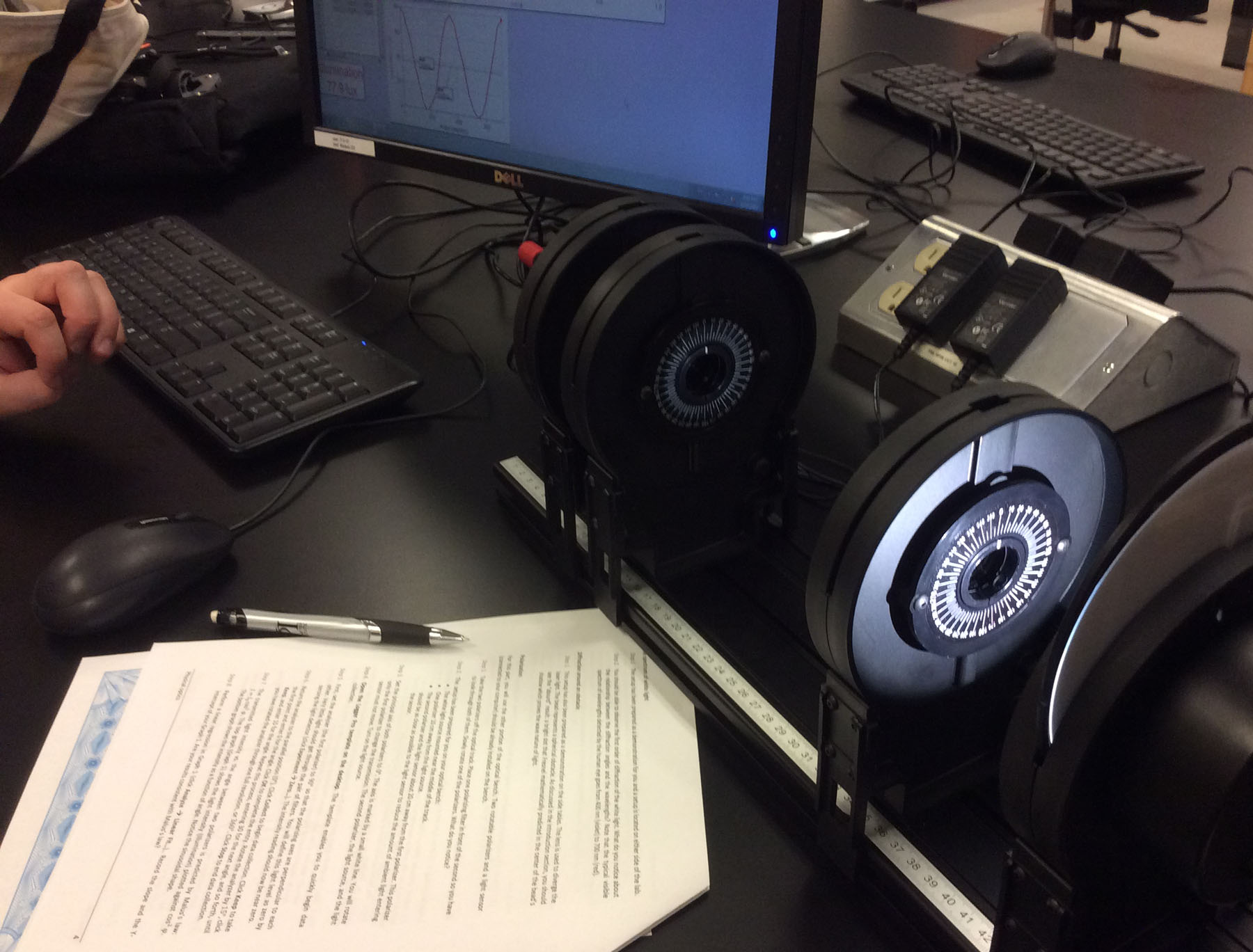
Our own Diana Hall, and the 2014 winner of the
CAP Award for Excellence in Teaching High School in Ontario gave the next talk about her own career path that led to this award. She then told us about her prize — a weeklong trip to SnoLab! For this week she got to go down into the former nickel mine and work with the scientists, participating in the daily reality of life of a neutrino physicist. Sounds exotic, but Diana pointed out several examples of very ordinary problems and solutions, such as checking that coaxial cables are making the right contact at the center wire. Just like your cable TV connector… but for SnoLab’s detectors, repeat hundreds of times! Diana highlighted the fact that the research team is made of people of all different levels, and everyone’s contributions are respected and valued. If you know of a Physics teacher who is doing excellent work, please consider nominating them for the 2017 prize. Full information is available on the CAP website:
https://www.cap.ca/en/HSCTA The day ended with a tour of several labs and facilities around the U of O campus where researchers tried to give us a sampling of the variety of things that make up “Physics.” Here are a few pictures from that tour.
Here’s an exciting idea that could lead to a new way to analyse DNA — see that little chip? See it under the microscope? See that little rectangular hole in the chip? Well, cover it with a very thin film, zap it with an electric spark to make an even tinier hole in the film, then apply a mild electric field across the film in a salty solution of DNA. The salty solution moves through the tiny hole at a measurable rate (ion current) but the rate changes when a “big” piece of DNA moves through the hole and partly blocks it.
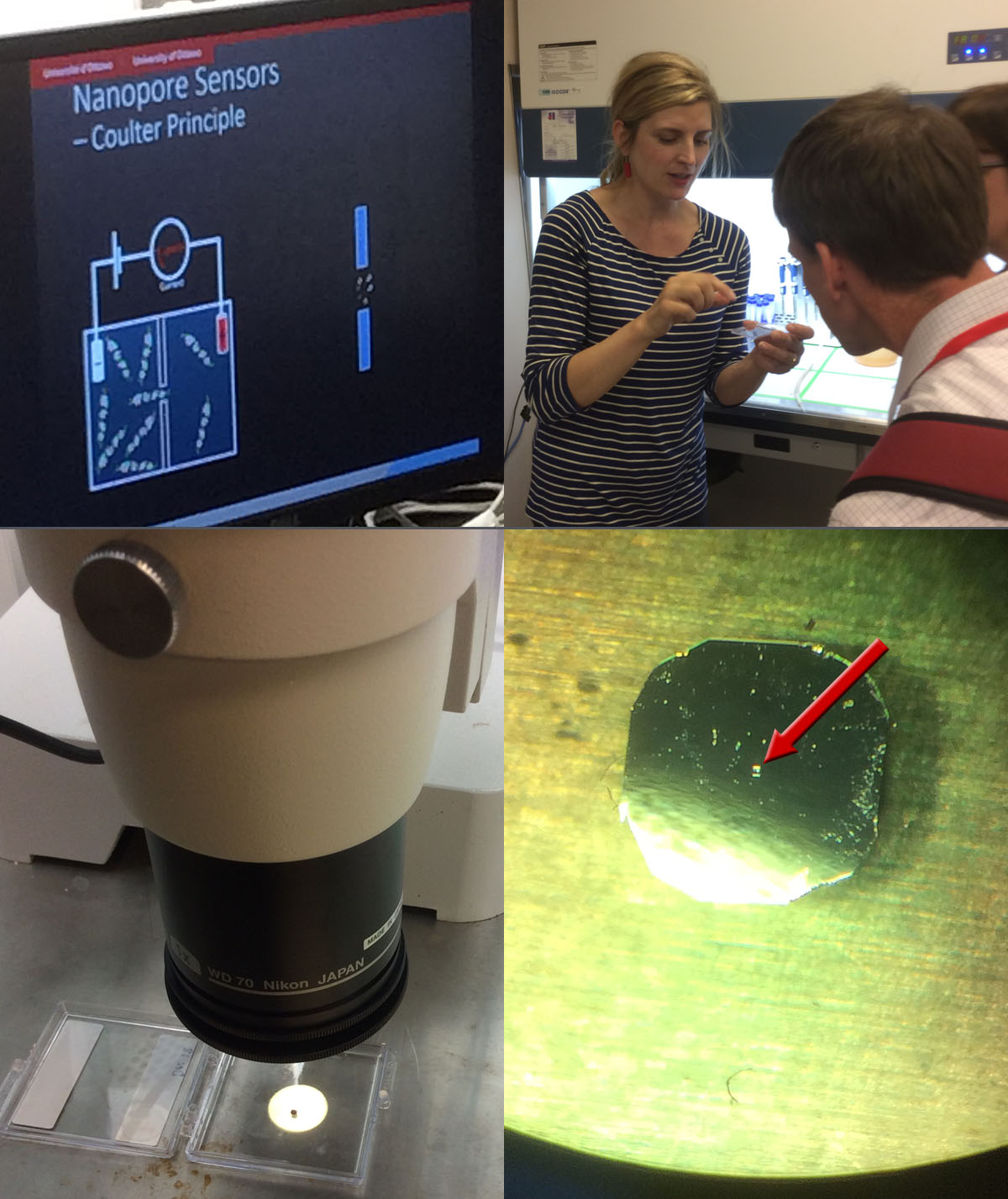
Another biophysics application: push stem cells through a microfluidic device, with a special substance that has a VERY large freeze-thaw hysteresis (look that one up!) and they get encapsulated. Encapsulated stem cells help medical researchers to deliver the stem cells to precisely controlled places in the body, as long as the stem cells can escape their capsules…
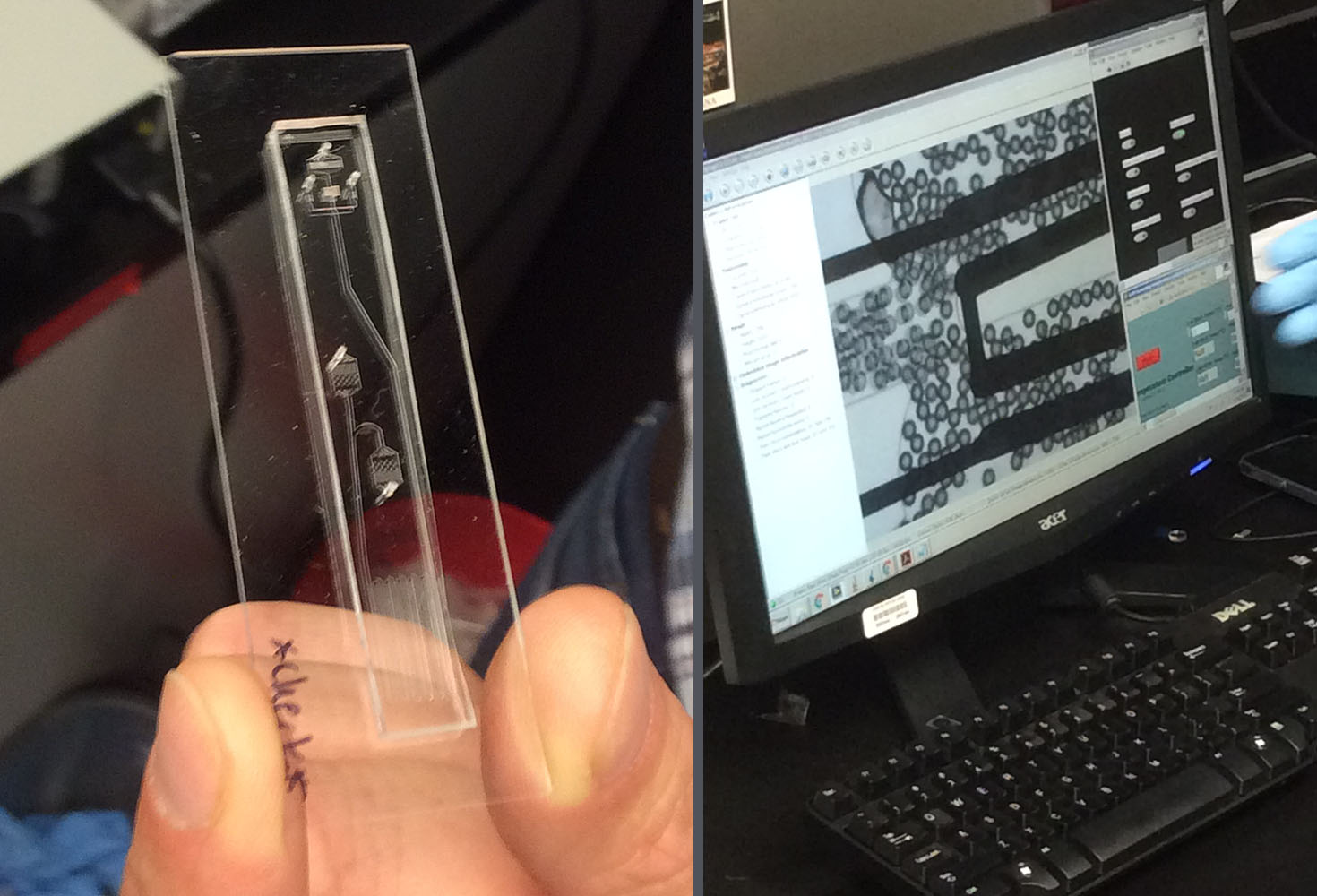
Here’s the Attosecond pulse generator described in the first lecture:
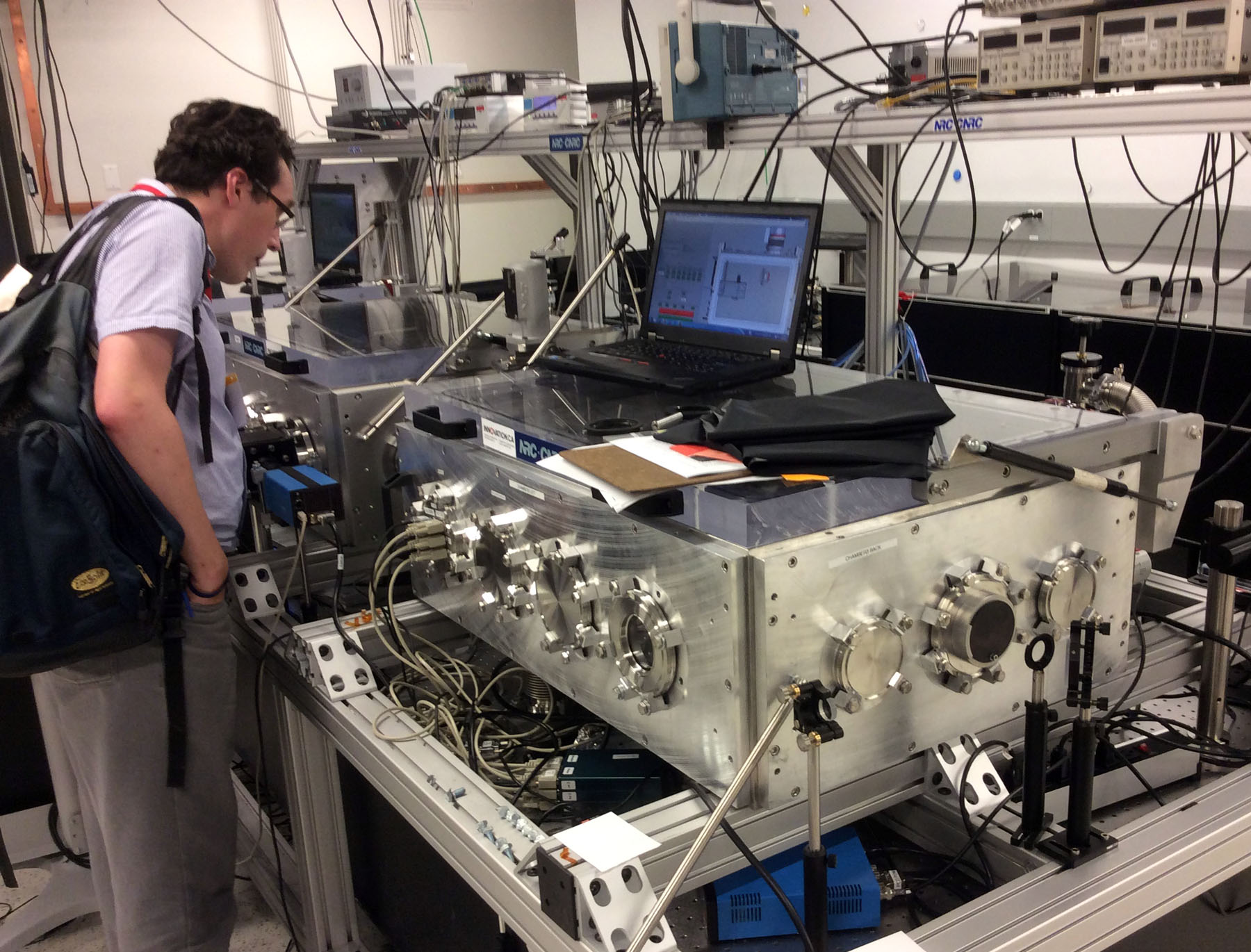
I was amused by the Physicist’s shopping list.
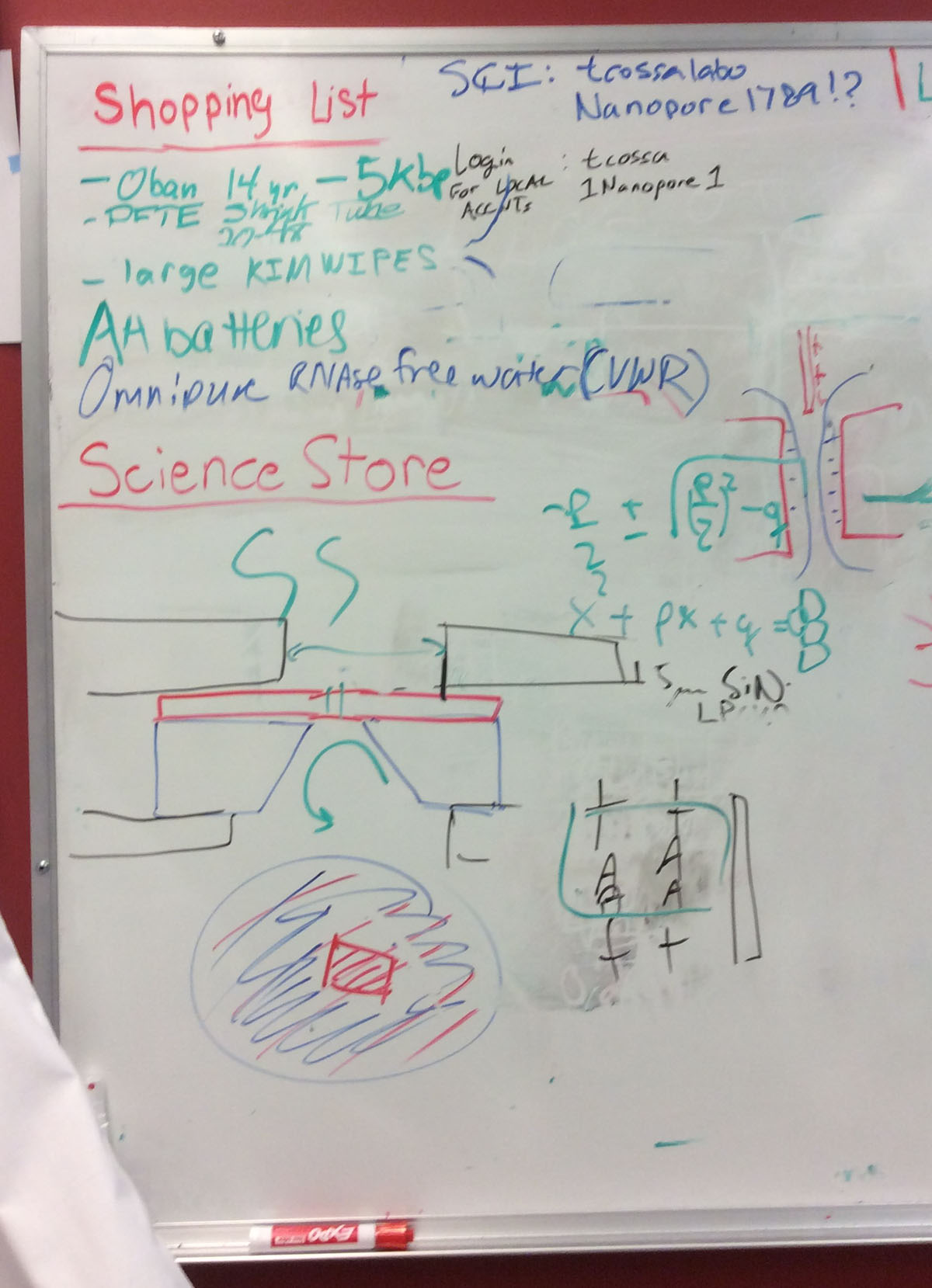
Tags: Field Trip, Professional Development






